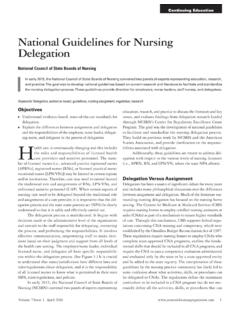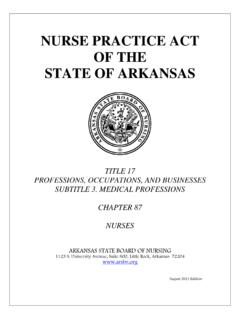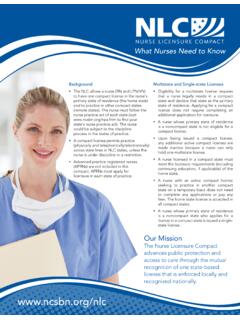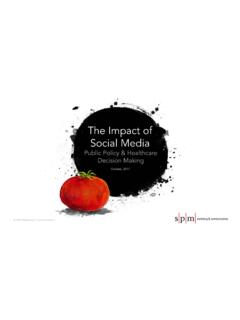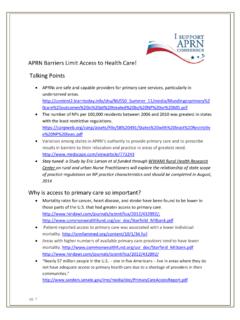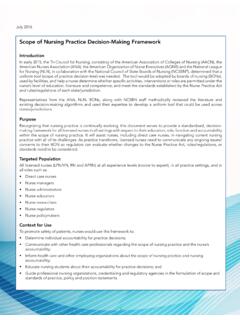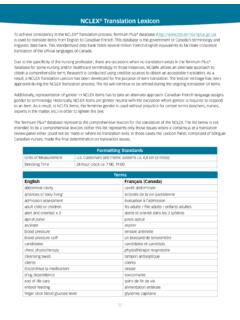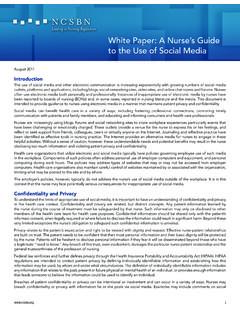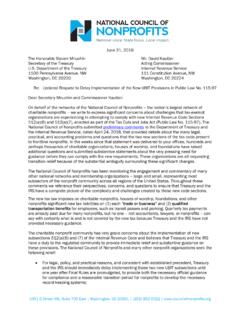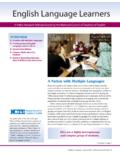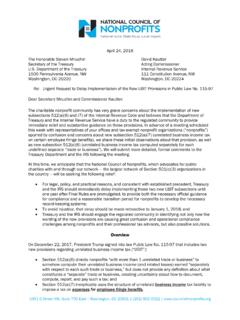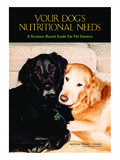Transcription of SUBSTANCE USE ER DISORDER IN NURSING - National …
1 SUBSTANCEUSEDISORDERIN NURSINGSUBSTANCE USE DISORDER IN NURSINGA Resource Manual andGuidelines forAlternative and DisciplinaryMonitoring Programs111 East Wacker DriveSuite 2900 Chicago, Illinois USE DISORDER INNURSINGA Resource Manual and Guidelines for Alternative and Disciplinary Monitoring Programs 2011 National Council of State Boards of NURSING , Inc. (NCSBN )Printed in the United States of rights reserved. No part of this publication may be reproduced, distributed, or transmitted in any form or by any means, including photocopying, recording, or other electronic or mechanical methods, without the prior written permission of NCSBN. Address inquiries in writing to NCSBN Permissions, 111 E. Wacker Drive, Suite 2900, Chicago, IL , NCLEX , NCLEX-RN NCLEX-PN Nursys , NNAAP and MACE are registered trademarks of 978-0-9826465-6-4 Chapter 1 Introduction and Purpose 1 Purpose of the Manual.
2 2 Use of Terms.. 3 SUBSTANCE Use DISORDER Committee .. 3 Chapter 2 SUBSTANCE Use, Abuse and Addiction 5 Etiology .. 5 Neurobiology of Addiction .. 7 Signs and Symptoms of Addiction in Nurses ..8 Stages of Addiction.. 8 Role of Family and Support Systems .. 10 Summary.. 10 Chapter 3 Risks and Protective Factors for Nurses 13 Different Rates of Abuse between Specialties .. 13 Gender and SUBSTANCE Abuse .. 14 Top Four Risk Factors .. 17 Summary.. 20 Chapter 4 Regulatory Management of Nurses with a SUBSTANCE Use DISORDER 25 State NURSING Practice Acts .. 25 The Traditional Disciplinary Approach.
3 25 Challenges of the Disciplinary Approach .. 27 Immediate Action.. 28 The Non-Disciplinary Approach .. 29 Contracts between the Board and Outside Monitoring Programs .. 30 Qualifications for Contractors or Subcontractors .. 31 Outreach and Education .. 32 Shared Information, Communication and Data Reporting.. 32 Audits and Evaluations .. 33 Other Ways to Ensure Accountability .. 34 CONTENTSiv Board Assistance with Referrals to Alternative Programs and Community Resources.. 38 Summary.. 38 Chapter 5 Screening, Intervention and Referral to Treatment 41 Brief Interventions .. 42 Summary.. 45 Chapter 6 SUBSTANCE Use DISORDER in the Workplace 49 Developing a Culture of Transparency and Support.
4 49 Supportive Workplace Environment .. 51 Lateral Violence and Stress.. 52 Education in the Workplace .. 53 Value of Proactive Policies and Procedures .. 55 Prevention of Diversion .. 56 Regular Monitoring as Prevention .. 57 Internal Investigations .. 58 Managing the Nurse with a SUBSTANCE Use DISORDER .. 58 Identification of a SUBSTANCE Use DISORDER .. 59 Identifying and Investigating Reports of Impaired Practice .. 61 Documentation During a Workplace Intervention .. 64 Action Plan .. 65 Implementation .. 67 Practical Tips .. 68 Follow-Up .. 69 Return to Practice.. 69 Indicators of Relapse .. 71 Reporting Nurses with a SUBSTANCE Use DISORDER .. 71 Reporting Guidelines to Boards of NURSING .. 72 Filing Complaints to the Board of NURSING .
5 72 Traditional Discipline and Alternative Programs .. 73 Summary.. 74 Chapter 7 Types of Programs 79 Models of Disciplinary Alternatives for Nurses with a SUBSTANCE Use DISORDER .. 80 Alternative Program Models .. 80 Disciplinary Models .. 83 Policies and Procedures .. 87 Information Available to the Board .. 87 Advantages of the Alternative Program .. 88 Controversies about Alternative Programs and Boards of NURSING .. 89 Summary.. 91 Chapter 8 Program Entry 93 Admission Criteria for Alternative Programs .. 93 Screening and Assessment Guidelines .. 94 Initial Intake Assessment Procedures for Admission into the Alternative Program.
6 95 vComprehensive Clinical Assessment .. 97 Maintaining Current and Effective Treatment Referrals in the Community 99 Summary..101 Chapter 9 Alternative to Discipline Program Participant Contracts 105 Initial Entry Requirements..109 Mandatory Treatment and Recovery Monitoring Requirements ..109 Practice Requirements and Limitations .. 110 Return to Work .. 110 Program Notification Requirements .. 111 Special Contracts and Provisions for Nurses Prescribed Potentially Addicting or Impairing Medications.. 112 Special Contracts and Provisions for Psychiatric Monitoring.
7 113 Special Contracts and Provisions for Nurses with Chronic or Acute Pain Issues.. 113 Completion of Alternative Program .. 113 Criteria for Success for Nurse Participants.. 114 Criteria for Success for Programs ..115 Criteria for Success for Employers .. 115 Criteria for Success for the Public.. 115 Chapter 10 Treatment and Continuing Care 117 Continuum-of-Care Model.. 119 The Change Process and the Transtheoretical Model.. 119 Elements and Stages ..120 Stages of Recovery ..121 Professional Support Groups ..122 Online Support Groups and Treatment..123 Case Management ..123 Medication Management in the Treatment of a SUBSTANCE Use DISORDER ..124 SUBSTANCE Use DISORDER and Mental Health disorders .
8 125 Recovery and Relapse Issues ..126 Summary..127 Chapter 11 Return-to-Work Guidelines 133 Return-to-Work Contracts and Releases ..134 Qualifications for Supervisors and Work-Site Monitors ..135 Procedures for Receiving Updates from the Monitoring Program ..137 Return to School Rather than the Workplace ..137 Chapter 12 Monitoring and Compliance 139 Relapse and Program Noncompliance ..140 Drug and Alcohol Testing ..141 Drug Screening Compliance Issues and Recommendations ..142 Recommendations for Uniform and Standardized Review ..142 Submission of a Positive Drug Screen ..142 Failure to Submit a Drug Screen.
9 143 Refusal to Submit to Testing..144 Submission of a Dilute Specimen ..144vi Submission of a Substituted or Adulterated Specimen..144 Noncompliance with Employment Limitations or Restrictions ..145 Noncompliance with Treatment Requirements ..145 Criteria for Referral to the Board ..145 Termination Criteria ..146 Board Responsibilities ..146 Completion of Alternative Program ..147 Criteria for Success with Nurse Participants..147 Summary..147 Chapter 13 Drug Testing 149 Guiding Principles ..149 Terminology..150 Key Parameters in Urine Drug Screening ..151 What Drugs Must Be Screened ..154 Drug Testing Thresholds (Cutoffs).
10 154 The Challenge of Alcohol (Ethanol) Testing ..156 Ethyl Glucuronide (EtG) and Ethyl Sulfate (EtS) ..156 Comparison of Detection Times for Ethyl Glucuronide (EtG), Ethyl Sulfate (EtS) and Ethanol..156 Evaluation of Alcohol Ingestion..157 Hair Testing ..157 Description of Services for Drug Testing Service Providers ..157 DTSP Laboratory Results ..159 Summary..160 Chapter 14 The Importance of Outreach and Education for Alternative Programs 163 Education and the Workplace Culture ..163 Transtheoretical Model..164 CAGE Model ..164 Modes of Outreach ..165 Online Programs ..165 Special Educational Strategies..166 Target Audiences ..167 Continuing Education Topics ..168 Online Educational Resources..169 Strategic Planning for Outreach and Education.

